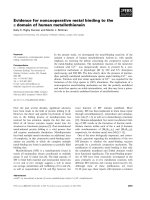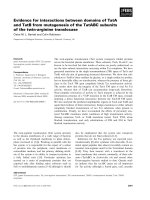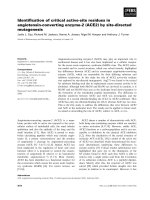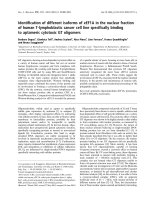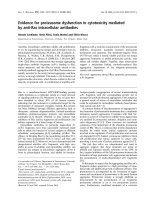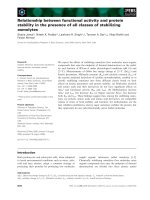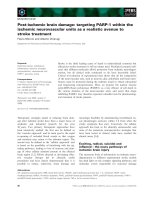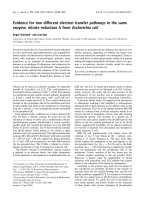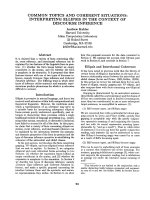Báo cáo khoa học: Evidence for two different electron transfer pathways in the same enzyme, nitrate reductase A from Escherichia coli potx
Bạn đang xem bản rút gọn của tài liệu. Xem và tải ngay bản đầy đủ của tài liệu tại đây (363.7 KB, 8 trang )
Evidence for two different electron transfer pathways in the same
enzyme, nitrate reductase A from
Escherichia coli
Roger Giordani* and Jean Buc
Laboratoire de Chimie Bacte
´
rienne, Institut Fe
´
de
´
ratif ‘Biologie Structurale et Microbiologie’, Centre National de la Recherche
Scientifique, Marseille, France
In order to clarify the role of cytochrome in nitrate reductase
we have performed spectrophotometric and stopped-flow
kinetic studies of reduction and oxidation of the cytochrome
hemes with analogues of physiological quinones, using
menadione as an analogue of menaquinone and duro-
quinone as an analogue of ubiquinone, and comparing the
results with those obtained with dithionite. The spectropho-
tometric studies indicate that reduction of the cytochrome
hemes varies according to the analogue of quinone used, and
in no cases is it complete. Stopped-flow kinetics of heme
oxidation by potassium nitrate indicates that there are two
distinct reactions, depending on whether the hemes were
previously reduced by menadiol or by duroquinol. These re-
sults, and those of spectrophotometric studies of a mutant
lacking the highest-potential [Fe-S] cluster, allow us to pro-
pose a two-pathway electron transfer model for nitrate
reductase A from Escherichia coli.
Keywords: cytochrome b; electron transfer; Escherichia coli;
nitrate reductase A; quinone.
Nitrate can be used as an electron acceptor for anaerobic
growth of Escherichia coli [1,2]. This oxidoreduction is
catalysed by nitrate reductase A (EC 1.7.99.4). This enzyme
is a membrane-bound complex of three subunits, designated
a, b and c, coded by three genes, narG, narH and narJ,
which form a single operon [3–5]. The a and b subunits are
located on the cytoplasmic side of the membrane and form
an ab complex that binds to the membrane by interacting
with the c subunit, a very hydrophobic protein embedded
inthemembrane[4].
Each subunit carries a different set of redox centers [5,6].
The 139 kDa a subunit contains the active site for the
reduction of nitrate to nitrite and a molybdenum cofactor
(molybdopterin guanine dinucleotide); a recent crystallo-
graphic study has revealed the presence of a new [4Fe-4S]
cluster [7] in the a subunit. The 58 kDa b subunit contains
four [Fe-S] clusters which belong to two classes: a high-
potential and a low-potential class. The high-potential class
contains [4Fe-4S] and [3Fe-4S] clusters with redox potential
of +180 mV and +130 mV, respectively. Redox potentials
of )55 and )420 mV correspond to two [4Fe-4S] clusters in
the low-potential class. The 20 kDa c subunit is a hydro-
phobic cytochrome of type b carrying two hemes [8–10].
The electron transfer in membranous enzyme requires
a quinone as an electron donor, and either ubiquinone
(a benzoquinone) or menaquinone (a naphthoquinone) can
fulfil the role [11]. A steady-state kinetic study of nitrate
reductase was carried out by Morpeth et al.[12].Unfortu-
nately, however, this study did not take account of the
stoichiometry of the reaction and in consequence gave
incorrect rate equations and led to hazardous conclusions.
A previous kinetic study [13] suggested that duroquinol
(a ubiquinone analogue) and menadiol (a menaquinone
analogue) deliver their electrons at two different sites on the
nitrate reductase. The loss of the highest-potential [4Fe-4S]
cluster in a mutant form of nitrate reductase results in an
enzyme devoid of menadione activity, but still retaining
duroquinone activity. The existence of a specific site of
reaction for each quinol, together with the differences in the
effects on the two quinols produced by loss of an [Fe-S]
cluster, suggested the possibility of two separate pathways
for transfer of electrons from duroquinol and menadiol in
nitrate reductase A [13].
EPR [9] and potentiometric [14] studies show the
existence of two b type hemes in the c subunit, cyto-
chrome b, of nitrate reductase A. The data from these
studies support the assignment of the axial ligands to the
low-potential heme (b
L
)(E
m
,
7
¼ 20 mV) and to the high-
potential (E
m
,
7
¼ 120 mV) heme (b
H
), respectively, located
near the periplasmic and the cytoplasmic side of the
membrane. Correct insertion of the two hemes into the
c subunit requires anchoring to the ab complex [9,10].
Moreover, a kinetic study by stopped-flow of nitrate
reductase with menadione only [15], exhibits four kinetic
phases in the reduction of the hemes by menaquinol.
According to the quinone type used, the two hemes of
the cytochrome are probably involved in the transfer of
electrons from the two specific binding sites and the two
specific pathways suggested [13] for transport of electrons
from the two quinol types to [Fe-S] clusters, molybdenum
cofactor and nitrate. To clarify the role of the hemes we
have made spectral and kinetic studies of the reduction
of these hemes with various analogues of physiological
Correspondence to J. Buc, Laboratoire de Chimie Bacte
´
rienne, 31
chemin Joseph-Aiguier, B.P. 71, 13042 Marseille Cedex 20, France.
Fax: + 33 491 7189 14, E-mail:
Abbreviations: HOQNO, 2-n-heptyl-4-hydroxyquinoline-N-oxide.
Enzyme: nitrate reductase A (EC 1.7.99.4).
*Present address:Faculte
´
de Pharmacie, Universite
´
de la Me
´
diterrane
´
e,
13385 Marseille Cedex 05, France.
(Received 17 March 2004, revised 8 April 2004,
accepted 14 April 2004)
Eur. J. Biochem. 271, 2400–2407 (2004) Ó FEBS 2004 doi:10.1111/j.1432-1033.2004.04159.x
quinones and compared the results with those obtained with
dithionite. Oxidation of reduced hemes was followed after
addition of potassium nitrate. In view of the rapidity of the
reduction and oxidation reactions, the kinetic studies needed
to be made with a stopped-flow apparatus.
Experimental procedures
Reagents and chemicals
Menadione (2-methyl-1,4-naphthoquinone), and duroqui-
none (tetramethyl-p-benzoquinone) were purchased from
Aldrich. Juglone (5-hydroxy-1,4-naphthoquinone), plumb-
agin (5-hydroxy 2-methyl-1,4-naphthoquinone), coen-
zyme Q
0
(2,3-dimethyl 5-methyl-p-benzoquinone) and
benzyl viologen were from Sigma. All other chemicals were
of the highest grade of purity commercially available, and
were supplied either by Prolabo or Merck.
Bacterial strains and plasmids
The strains used in this study were LCB2048
(DNRA,DNRZ) as strain devoid of nitrate reductase [16],
pVA700, pJF119EH(narGHIJ)Ap
r
, as overexpressed wild-
type plasmid [17] and pVA700-C16, pJF119EH(nar-
GH[C16A]IJ)Ap
r
, as plasmid lacking the high-potential
[4Fe-4S] cluster [17].
Growth conditions
Growth conditions were those described previously [17]. All
strains were grown anaerobically at 37 °ConTYmedium
supplemented with glucose (2 gÆL
)1
). Expression of nitrate
reductase was induced by isopropyl thio-b-
D
-galactoside
(0.2 l
M
) (pVA700). The antibiotics ampicillin (50 mgÆL
)1
)
and chloramphenicol (10 mgÆL
)1
)wereused.
Preparation of subcellular fractions
Cells were harvested during the exponential phase of growth
and suspended in 100 m
M
potassium phosphate buffer
pH 6.6 and disrupted at 69 MPa by passage through a
French press. The resulting suspension was centrifuged
(for 15 min at 18 000 g) to sediment unbroken cells. The
supernatant was further centrifuged for 90 min at a maxi-
mum of 120 000 g, and the new supernatant was discarded
while the pellet was retained. All of these procedures were
performed at 4 °C. The pellets, containing nitrate reductase
as a complete membrane-bound complex, were resuspended
in a small volume of buffer and stored at )80 °C until use.
Quantification of nitrate reductase
The concentration of nitrate reductase was estimated by
reference to the percentage of enzyme in the total protein.
This percentage was determined from the percentage of
nitrate reductase antigen present in nitrate reductase
membranous preparations measured by rocket immuno-
electrophoresis [18] as described previously [19]. Proteins
were estimated by the technique of Lowry et al. [20] using
bovine serum albumin as standard. The amount of over-
expressed enzymes was about 10-times that in the parent
strain MC4100. With the plasmids used here, which express
the genes stoicheiometrically, about 90% of the enzyme is
membrane-bound (further details in [17]).
Enzyme assays
Nitrate reductase activity with benzyl viologen as substrate
was measured spectrophotometrically [21] by nitrate-
dependent oxidation of reduced benzyl viologen, with the
precautions described previously [22].
Nitrate reductase activities with quinols as substrates
were measured by a spectrophotometric method as des-
cribed previously [22].
Spectra
These were obtained with a Hitachi U-2000 spectro-
photometer, thermostated at 37 °C and connected to a
personal computer. All experiments were performed in
50 m
M
potassium phosphate buffer pH 6.6. A 1.6 mL
quartz cuvette closed by a Teflon cap with a central hole
was used to allow the different reagents to be added with
a microsyringe. Thorough mixing in the cuvette was
achieved by displacement of glass beads. As the mem-
branes were from strains with nitrate reductase over-
expressed, amounts of membrane low enough to avoid
turbidity could be used.
Reduction of quinone analogues
Quinone analogue solution (1.7 mL of 20 m
M
, in ethanol)
were added to 70 mg of zinc powder and 60 lLof5
M
HCl,
after mixing and sedimentation of the zinc the reduced
analogue solution could used for two or three hours. This
technique, used in organic chemistry [23], is very efficient
and is easier to use than that with KBH
4
,whichwas
previously employed in nitrate reductase assays [22].
Stopped-flow kinetics
Stopped-flow kinetic measurements were made with a
Hi-Tech Scientific FF61 apparatus (Salisbury, UK) con-
nected to a personal computer. The stopped-flow appar-
atus was equipped with a 1 cm light-path quartz cuvette.
To minimize oxygen leaks, the drive system was sub-
merged in a thermostatically controlled circulating water
bath at 37 °C. The stopped-flow system was thoroughly
flushed with anaerobic buffer (50 m
M
potassium phos-
phate, pH 6.6) immediately before the experiments were
started. Solutions were equilibrated to assay temperature
before experiments. To measure the absorbance at
560 nm, measurement of baselines were established at
each wavelength with anaerobic buffer, and the values
obtained were typically within 5% of those obtained from
the absorbance spectra of the same solutions recorded on
the Hitachi U-2000 spectrophotometer.
Analysis of data
A personal computer was used to fit experimental data to
appropriate equations by nonlinear least squares, using a
Newton–Gauss algorithm [24].
Ó FEBS 2004 Two electron transfer pathways in nitrate reductase (Eur. J. Biochem. 271) 2401
Results
Spectrophotometric studies with quinone analogues
Spectra were measured between 500 and 600 nm in order to
follow the redox state of the cytochrome by following the
characteristic peak at 560 nm.
If one takes as reference the reduction by dithionite, a
nonphysiological reducing agent that reduces the enzyme
completely and nonspecifically (heme, [Fe-S] clusters and
molybdedum cofactor) one can observe in the overexpressed
wild-type strain, a difference between reduced and oxidized
spectra, according to whether the subsequent reductant is
menadione or duroquinone (Fig. 1). In both cases the
maximum amplitude at 560 nm is less than that obtained
with dithionite, which seems to indicate that the reduction
of the hemes of the cytochrome varies according to the
analogue of quinone used, and in neither case is it complete.
Use of a strain devoid of nitrate reductase (LCB 2048)
makes very clear the lack of any signal at 560 nm (Fig. 1,
trace 4).
Reduction by analogues is performed by addition of
small quantities of reduced analogue until there is no further
change in signal. To reduce quinone analogues, the reducing
agent used was KBH
4
followed by zinc. Zinc in the presence
of HCl has been preferred, as it gives a more reliable and
stable reduction in one step with the advantage of not
diluting the reducing solutions, thus allowing the addition of
smaller quantities for the same reducing effect. In any event,
the results obtained are equivalent whatever the mode of
reduction of analogues of quinone used. The reduction
of membranes with dithionite is performed by addition of
dithionite powder.
These experiments have been carried out using a range of
concentrations in membrane at the limit of turbidity of the
solution (0.193–2.09 l
M
). In all cases one obtains similar
results (Fig. 1) that show the variation of the amplitude of
the signal at 560 nm between reduced and oxidized forms
by the nitrate according to the concentration in nitrate
reductase with the three electron donors used (dithionite,
menadiol and duroquinol).
In the concentration range used, the amplitude of
absorbance reduced minus oxidized is linearly correlated
with the concentration of nitrate reductase (Fig. 2) whatever
the reducing agent used, the correlation coefficients of least-
square regressions being 0.98, 0.98 and 0.96 for dithionite,
menadiol and duroquinol, respectively.
One can determine the slopes of the three straight lines
obtained with the three electron donors. These slopes
correspond to the differences in molecular extinction
coefficients of reduced and oxidized forms of the hemes,
and therefore to apparent molecular extinction coefficients
corresponding to maximal reduction of the various electron
donors: 0.069 l
M
)1
Æcm
)1
for dithionite, 0.059 l
M
)1
Æcm
)1
for menadiol and 0.031 l
M
)1
Æcm
)1
for duroquinol.
These values have induced us to verify with other
analogues whether there are differences in amplitudes of
the peak at 560 nm between reduced and oxidized forms.
Fig. 1. Difference spectra of membranous nitrate reductase. Mem-
branous enzyme was reduced by (1) dithionite, (2) menadiol and (3)
duroquinol. Reductions were obtained by addition of small amounts
of reduced analogues or dithionite until no further change in the
spectrum. Oxidations were performed by addition of nitrate. Trace (4)
was obtained with a strain lacking nitrate reductase (LCB 2048) and
dithionite as reductant. The membranous nitrate reductase concen-
tration was 1.2 l
M
in all cases.
Fig. 2. Variation of absorbance difference between reduced and oxidized
membranous nitrate reductase vs. enzyme concentration. Membranous
nitrate reductase was reduced by (1) dithionite, (2) menadiol and (3)
duroquinol. Lines were obtained by least-squares fitting, the slopes of
these lines being consistent with the apparent molecular extinction
coefficients. The absorbances were measuered at 560 nm.
2402 R. Giordani and J. Buc (Eur. J. Biochem. 271) Ó FEBS 2004
We have used analogues of type ubiquinone (lapachol
and Coenzyme Q
0
and decylubiquinone), and analogues
of type menaquinone (plumbagine and juglone). These
studies have been undertaken with various enzyme
concentrations to permit us to obtain the apparent
molecular extinction coefficients (Table 1). Except for
decylubiquinone, which induces flocculation in the cuvette,
we obtained a difference of amplitude of the peak at
560 nm between the form reduced by analogues and the
form oxidized by nitrate, and in all cases this difference
was less than that obtained with dithionite. The differences
of molecular extinction coefficients for reduced and
oxidized forms can be grouped into two classes according
to their values, the analogues of ubiquinone and those of
menaquinone, these last having larger differences of
coefficients than the first. This is not surprising, because
menaquinols are the preferred electron donors for nitrate
reductase in anaerobic conditions [25].
These analogues (lapachol, plumbagine, etc.), unlike
menadiol and duroquinol, give spectra with significant
baselines in the absence of membrane, necessitating
corrections to the spectra. In addition, the specific
absorption of analogues at 560 nm complicates the kinetic
study of reduction of the cytochrome according to the
choice of menadiol and duroquinol for spectral and
kinetic studies.
Influence of HOQNO on spectra
The presence of the menaquinone analogue 2-n-heptyl-4-
hydroxyquinoline-N-oxide (HOQNO) in the medium inhib-
its reduction of the cytochrome by menadiol, but does not
inhibit reduction by duroquinol (Fig. 3). It is probable that
the nucleus of the HOQNO molecule, similar to that of
duroquinone, i.e. a nucleus of type benzoquinone, specific-
ally inhibits the site for menadiol, as predicted by previous
studies showing cross-inhibition of menadiol and duro-
quinol on the binding of these electrons donors to the
cytochrome b of nitrate reductase [13].
These results with HOQNO explain those of Rothery
et al. [23], who found a site of interaction between the
cytochrome and the quinones by studying inhibition of the
nitrate reductase activity by HOQNO. It has therefore
clarified the binding site of the menaquinols, but for technical
reasons it cannot reveal the site for the ubiquinols, because
HOQNO does not inhibit binding of the ubiquinols.
Kinetic studies by stopped-flow
We have studied oxidation by nitrate of the cytochrome
of nitrate reductase, preliminarily reduced by an analogue
of quinone, menadiol or duroquinol. We have made
experiments at various concentrations of electron donors
and nitrate, in each case for several ranges of time
(0.5–5 s). The traces obtained are shown in Fig. 4. They
are monophasic and fit a decreasing exponential equation.
The amplitudes obtained agree with those obtained during
spectrophotometric studies (Fig. 1). The time constants
corresponding to apparent rate constants are obtained by
fitting Eqn (1):
DAbs ¼ a þ b e
Àct
ð1Þ
where, DAbs is the variation of absorbance, a and b are
amplitude parameters and c is the time constant.
The time constants are different according to whether the
enzyme has been reduced by menadiol or by duroquinol;
the results are listed in Table 2.
Whatever the experimental conditions, the apparent rate
constant is 1 s
)1
with menadiol, whereas it is 2 s
)1
with
duroquinol. This doubling of the apparent rate constants
indicates that there are two distinct reactions, and so
oxidation of the cytochrome by nitrate follows separate
pathways according to the nature of the electron donor.
The kinetics of reduction of the cytochrome is very
complex. In time ranges from 0.5 to 10 s, one observes traces
corresponding to the sum of three exponentials at least.
These traces are too complex to be analysed with precision.
The residual plots, difference between experimental data
and calculated values obtained after fitting, shown in Fig. 4,
Table 1. Apparent molecular extinction coefficients between reduced
and oxidized membranous nitrate reductase for different reductants.
e values were obtained by least-squares fitting, like those presented in
Fig. 2.
Reductant E
m
(mV) e (l
M
)1
Æcm
)1
)
Artificial reductant Dithionite 0.069 ± 0.002
Menaquinone Menadione )1 0.059 ± 0.004
analogues Plumbagine )74 0.043 ± 0.001
Juglone +33 0.037 ± 0.005
Lapachol )179 0.046 ± 0.005
Ubiqinone Duroquinone +35 0.031 ± 0.04
analogues Coenzyme Q
0
+10 0.011 ± 0.03
Fig. 3. Variation of reducing of membranous nitrate reductase by quinol
analogues vs. HOQNO concentration. The enzyme was reduced with
duroquinol (j)ormenadiol(d). The nitrate reductase concentration
was 0.6 l
M
. Lines were obtained by least-squares fitting.
Ó FEBS 2004 Two electron transfer pathways in nitrate reductase (Eur. J. Biochem. 271) 2403
were distorted at the origin. These deviations were due to
the time needed for a homogenous system to be reached
after mixing of the membrane suspension and nitrate
solution during the beginning of measurement for each
experiment. Apart from these artifacts the distributions of
the residuals show a good agreement between experimental
data and the plot obtained by fitting.
The traces obtained are comparable to these obtained by
Zhao et al. [15]. These authors found four phases in the
reduction of the cytochrome by menadiol, phases arbitrarily
attributed to particular steps in the scheme that they
proposed for the mechanism of reduction. Unfortunately,
however, this scheme does not agree with the results from
steady-state kinetics that we have obtained in a previous
study [13]. There we showed that the catalytic mechanism
implied an intermediate complex incompatible with binding
of the electron donor and allowing it to give its two electrons
successively before being released.
Spectrophotometric studies with a mutant lacking
the highest-potential iron sulphur cluster
Use of a mutant (pVA700-C16) whose nitrate reductase has
lost the highest-potential [4Fe-4S] cluster has allowed us to
confirm the existence of these two pathways of electron
transfer in the enzyme. Figure 5 shows reduction of the
cytochrome of this mutant by dithionite, menadiol or
duroquinol, followed by reoxidation by nitrate. The cyto-
chrome is unambiguously reduced, regardless of the electron
donor. On the other hand, although the enzyme reduced
by duroquinol is fully oxidized by nitrate, that reduced by
menadiol is not oxidized. This result agrees with the
conclusions from the steady-state kinetics [13] which showed
that in the case of this mutant no menadione oxidase
activity was observed even though duroquinone oxidase
activity was present. The result obtained with dithionite
confirms this conclusion; indeed, even through the reduction
is total, the oxidation is only partial, with the fraction of
oxidation corresponding to that observed for duroquinol.
These results indicate therefore that the [Fe–S] clusters
do not have the same role in electron transfer in nitrate
reductase. The [4Fe-4S] cluster of high-potential would
therefore be the indispensable relay for the transfer of
electrons when menadiol is the electron donor, and the
[3Fe-4S] cluster would be implied in the transfer of electrons
when duroquinol is used.
Fig. 4. Oxidization of membranous nitrate reductase previously reduced
by quinone analogues. Absorbance changes observed, at 560 nm, after
mixing enzyme (3.14 l
M
) reduced by menadiol (A) or duroquinol (B)
with an equal volume of nitrate (40 m
M
)at37°C. The traces are fitted
to Eqn (1) DAbs ¼ a + b e
)ct
which corresponds to a decreasing
exponential. The apparent kinetic constants were 1 s
)1
for enzyme
reduced by menadiol and 2 s
)1
for enzyme reduced by duroquinol. The
distributions of residuals after fitting data from traces (A) and (B) to
Eqn (1) are shown, respectively, in plots (C) and (D).
Table 2. Comparison of kinetic contants of oxidation by nitrate of
nitrate reductase hemes reduced by menadiol or duroqinol. Values of
kinetic constants were averages of several experiments in different time
ranges (0.5, 1, 2 and 5 s). The membranous nitrate reductase concen-
tration was in all cases 1.57 l
M
.
[Quinol] (m
M
) [KNO
3
](m
M
)k(s
)1
)
Menadiol
0.768 100 1.065 ± 0.034
0.576 0.964 ± 0.042
0.384 1.043 ± 0.075
0.768 20 1.184 ± 0.068
0.576 1.029 ± 0.046
0.384 0.932 ± 0.100
Mean 1.027 ± 0.062
Duroquinol
0.768 100 1.830 ± 0.017
0.576 2.069 ± 0.018
0.384 2.120 ± 0.055
0.768 20 1.841 ± 0.092
0.576 2.026 ± 0.067
0.384 2.006 ± 0.019
Mean 1.988 ± 0.094
2404 R. Giordani and J. Buc (Eur. J. Biochem. 271) Ó FEBS 2004
Discussion
Steady-state kinetic studies [13] have shown the existence of
two specific binding sites for menadiol and duroquinol. This
situation recalls that described for fumarate reductase from
Escherichia coli, where the separation of oxidative and
reductive activities suggests there are two quinol binding
sites and that electron transfer occurs in two one-electron
steps at these sites [26]. The presence of these two sites has
been corroborated by crystallographic studies, with two
binding sites termed Q
P
and Q
D
indicating their positions
proximal or distal to the site of fumarate reduction; the use
of the quinol-binding site inhibitor HOQNO shows that the
inhibitor blocks binding of MQH
2
at the Q
P
site [27].
Study of the reduction and oxidation of the cytochrome
has brought us to the conclusion that the two hemes do not
have the same role. In particular, kinetic results with the
stopped-flow apparatus for the oxidation of the cytochrome
show that there are two distinct reactions, two apparent
kinetic constants differing by a factor of two.
Previous studies [13], as well as reduction and oxidation
spectra by nitrate of the cytochrome of a mutant strain
having lost the highest-potential [4Fe-4S] cluster, show that
b clusters do not play the same role in the transfer of
electrons between the cytochrome and the molybdenum
cofactor. This [4Fe-4S] cluster is the indispensable relay
when the donor is menadiol. The [3Fe-4S] cluster may be the
relay when the donor is duroquinol. We can therefore
conclude that the transfer of electrons up to the molyb-
denum cofactor in nitrate reductase follows two distinct
pathways according to the nature of the electron donor,
as illustrated in Fig. 6.
As the reduction of nitrate to nitrite requires two
electrons, there must necessarily be two successive bindings
of quinone, with transfer of one electron to the hemes, then
to the [Fe-S] cluster, to be finally accumulated at the level of
the molybdenum cofactor to be able to undertake the
catalytic reaction.
The location of the hemes has been studied by Rothery
et al. [28,29]. These authors showed that the low-potential
heme b
L
, located on the periplasmic side of the membrane,
is associated with a single quinol-binding site. However,
the technique used to determine binding sites of quinols,
inhibition by HOQNO (a structural analogue of menaqui-
none), did not allow them to see the binding site of
ubiquinol because HOQNO is not an inhibitor for the
ubiqinones. Indeed, cocrystallization of quinol fumarate
reductase with HOQNO shows that HOQNO can inhibit
the menaquinol binding site but not the ubiquinol binding
site [27]. Consequently, the low-potential heme located on
the periplasmic side of the membrane appears to be
associated with a binding site for menaquinols, but it is
highly probable that the high-potential heme b
H
, located on
the cytoplasmic side, was associated with the binding site for
ubiquinols. This conclusion agrees with structural data that
indicate a cavity containing two distinct regions directly
adjacent to the two hemes of c [7].
The four [Fe-S] clusters of b are positioned in two pairs
due to the fact of their coordination to the polypeptide
chain, each high-potential cluster being associated with a
low-potential cluster [10]. The crystal structure of b shows
two structural domains. Each domain contains a high-
potential [Fe-S] cluster and low-potential [Fe-S] cluster, the
two being sandwiched between two helices on one side, and
Fig. 5. Spectra of membranous nitrate reduc-
tase cytochrome of mutant devoid of the high-
est-potential [4Fe-4S] cluster. Reduced spectra
are shown as solid lines and oxidized spectra
as dotted lines. The nitrate concentration was
in all cases 0.95 l
M
.
Fig. 6. Proposed mechanism for electron transfer in nitrate reductase.
Menadiol and ubiquinol are symbolized by MQ and UQ, respectively.
The molybdenum cofactor and the two hemes are denoted CoMo, b
L
(low-potential heme) and b
H
(high-potential heme). This scheme is
consistent with the structural data of Bertero et al.[7].
Ó FEBS 2004 Two electron transfer pathways in nitrate reductase (Eur. J. Biochem. 271) 2405
a b-sheet on the other [7]. This structure is consistent with
the idea that the [Fe-S] clusters are coupled in two redox
units, each containing a low-potential and a high-potential
[Fe-S]. Thus each structural domain of b may be a transfer
unit for the electron transfer pathway in this enzyme. In our
scheme we have integrated these structural data supposing
that the two pairs of [Fe-S] cluster both participate. That
recalls that two parallel electron pathways towards the
a [4Fe-4S] cluster and the molybdenum cofactor with
involvement of high-potential [Fe-S] had been suggested,
supposing that the low-potential clusters play no redox role
[17]. Note that HOQNO and stigmatellin inhibit nitrate-
dependent heme reoxidation [28], suggesting the presence of
a second dissociable Q-site (the Q
nr
site) between heme b
H
and the [3Fe-4S] cluster [29]. Likewise our results are not at
variance with kinetic data for reduction of the enzyme by
menadiol [15], suggesting the existence of two menadiol
binding sites in the enzyme, one with higher affinity than the
other, as well as inhibition data indicating the possibility of
more than one menaquinol binding site in nitrate reductase
[15]. The fact that nitrate is able to oxidize heme b
H
but not
heme b
L
in the presence of an excess of quinol and HOQNO
[30] is consistent with our results showing inhibition by
HOQNO to the extent of reduction by menadiol and not
by duroquinol, and thus inhibition of duroquinone oxidase
activity.
The existence of these two pathways of electron transfer
may appear surprising, but nitrate reductase is one of the
rare enzymes of quinone-oxidase type that can accept both
menaquinol and ubiquinol as electron donor according to
conditions of growth.
Acknowledgements
WeareindebtedtoDrF.Blascoforhishelpintheconstructionof
mutant strains, to Dr G. Giordano for preparation of enzymes and to
Dr J. Pommier for performing the rocket assays. The authors express
their gratitude to Dr Wolfgang Nitschke (BIP, CNRS, Marseille) to
have allowed us to use a stopped-flow apparatus. We thank Dr
A. Cornish-Bowden for critical reading and correcting of the manuscript.
References
1. Pichinoty, F. (1969) Les nitrates re
´
ductases bacte
´
riennes.
I. Substrats, e
´
tat particulier et inhibiteurs de l’enzyme. Arch.
Mikrobiol. 68, 51–64.
2. Ruiz-Herrera, J. & DeMoss, J.A. (1969) Nitrate reductase com-
plex of Escherichia coli K-12: participation of specific formate
dehydrogenase and cytochrome b
1
components in nitrate reduc-
tion. J. Bacteriol. 99, 720–729.
3. Sodergren, E.J. & DeMoss, J.A. (1988) narI region of the
Escherichia coli nitrate reductase (nar) operon contains two genes.
J. Bacteriol. 170, 1721–1729.
4. Sodergren, E.J., Hsu, P.Y. & DeMoss, J.A. (1988) Roles of the
narJ and narI gene products in the expression of nitrate reductase
in Escherichia coli. J. Biol. Chem. 263, 16156–16162.
5. Blasco, F., Iobbi, C., Giordano, G., Chippaux, M. & Bonnefoy, V.
(1989) Nitrate reductase of Escherichia coli: completion of the
nucleotide sequence of the nar operon and reassessment of the role
of the a and b subunits in iron binding electron transfer. Mol.
Genet. 218, 249–256.
6. Guigliarelli, B., Asso, M., More, C., Augier, V., Blasco, F.,
Pommier, J., Giordano, G. & Bertrand, P. (1992) EPR and redox
characterization of iron-sulphur centers in nitrate reductase from
Escherichia coli. Evidence for a high-potential and a low-potential
class and their relevance in the electron-transfer mechanism. Eur.
J. Biochem. 207, 61–68.
7.Bertero,M.G.,Rothery,R.A.,Palak,M.,Hou,C.,Lim,D.,
Blasco, F., Weiner, J. & Strynadka, N.C. (2003) Insights into the
respiratory electron transfer pathway from the structure of nitrate
reductase A. Nat. Struct. Biol. 10, 681–687.
8. Hackett, N.R. & Bragg, P.D. (1982) The association of two
distinct b cytochromes with the respiratory nitrate reductase of
Escherichia coli. J. Bacteriol. 154, 719–727.
9. Magalon, A., Lemesle-Meunier, D., Rothery, R.A., Frixon, C.,
Weiner,J.H.&Blasco,F.(1997)Hemeaxialligationbythehighly
conserved His residues in helix II of cytochrome b (NarI) of
Escherichia coli nitrate reductase A (NarGHI). J. Biol. Chem. 272,
25652–25658.
10. Blasco, F., Guigliarelli, B., Magalon, A., Asso, M., Giordano, G.
& Rothery, R.A. (2001) The coordination and function of the
redox centres of the membrane-bound nitrate reductases. Cell
Mol. Life Sci. 58, 179–193.
11. Wallace, B.J. & Young, I.G. (1977) Role of quinones in electron
transport to oxygen and nitrate in Escherichia coli. Studies with a
ubiA
–
menA
–
double quinone mutant. Biochem. Biophys. Acta 461,
84–100.
12. Morpeth, F.F. & Boxer, D. (1985) Kinetic analysis of respiratory
nitrate reductase from Escherichia coli K12. Biochemistry 24,
40–46.
13. Giordani, R., Buc, J., Cornish-Bowden, A. & Cardenas, M.L.
(1997) Kinetics of membrane-bound nitrate reductase A from
Escherichia coli with analogues of physiological electron donors.
Different reaction sites for menadiol and duroquinol. Eur. J.
Biochem. 250, 567–577.
14. Rothery, R.A., Blasco, F., Magalon, A., Asso, M. & Weiner, J.H.
(1999) The hemes of Escherichia coli nitrate reductase A (Nar-
GHI): potentiometric effects of inhibitor binding to NarI. Bio-
chemistry 38, 12747–12757.
15. Zhao, Z., Rothery, R.A. & Weiner, J.H. (2003) Transient kinetic
studies of heme reduction in Escherichia coli nitrate reductase A
(NarGHI) by menaquinol. Biochemistry 42, 5403–5413.
16. Blasco, F., Pommier, J., Augier, V., Chippaux, M. & Giordano,
G. (1992) Involvement of the narJ or narW gene product in the
formation of active nitrate reductase in Escherichia coli. Mol.
Microbiol. 6, 221–230.
17. Guigliarelli, B., Magalon, A., Asso, M., Bertrand, P., Frixon, C.,
Giordano, G. & Blasco, F. (1996) Complete coordination of the
four Fe-S centres of the b subunit from Escherichia coli nitrate
reductase. Physiological, biochemical, and EPR characterization
of the site-directed mutants lacking the highest or lowest potential
[4Fe-4S] clusters. Biochemistry 35, 4828–4836.
18. Graham, A., Jenkins, H.E., Smith, N.H., Mandrand, M.A.,
Haddock, B.A. & Boxer, D.H. (1980) The synthesis of
formate dehydrogenase and nitrate reductase proteins in various
fdh and chl mutants of Escherichia coli. FEMS Microbiol. Lett. 7,
145–151.
19. Buc,J.,Santini,C.L.,Blasco,F.,Giordani,R.,Cardenas,M.L.,
Chippaux,M.,Cornish-Bowden,A.&Giordano,G.(1995)
Kinetic studies of a soluble ab complex of nitrate reductase A from
Escherichia coli.Useofvariousab mutants with altered b sub-
units. Eur. J. Biochem. 234, 766–772.
20. Lowry, O.H., Rosebrough, N.J., Farr, A.L. & Randall, R.J.
(1951) Protein measurement with the folin phenol reagent. J. Biol.
Chem. 193, 265–275.
21. Jones, R.W. & Garland, P.B. (1977) Sites and specificity of the
reaction of bipyridylium compounds with anaerobic respiratory
enzymes of Escherichia coli. Biochem. J. 164, 199–211.
2406 R. Giordani and J. Buc (Eur. J. Biochem. 271) Ó FEBS 2004
22. Buc, J. & Giordani, R. (1998) A spectrophotometric method for
kinetic studies with quinone-dependent oxidoreductases. Appli-
cation to detection in membranes of nitrate reductase activity with
menadione and duroquinone as electron donors. Enzyme Microb.
Technol. 22, 165–169.
23. Rothery, R.A., Chatterjee, I., Kiema, G., McDermott, M.T. &
Weiner, J. (1998) Hydroxylated naphthoquinones as substrates
for Escherichia coli anaerobic reductases. Biochem. J. 332, 35–41.
24. Cleland, W.W. (1967) The statistical analysis of enzyme kinetic
data. Adv. Enzymol. 29, 1–34.
25. Polglase, W.J., Pun, W.T. & Withaar, J. (1966) Lipoquinones of
Escherichia coli. Biochim. Biophys. Acta 118, 425–426.
26. Westenberg, D.J., Gunsalus, R.P., Ackrell, B.A.C. & Cecchini, G.
(1990) Electron transfer from menaquinol to fumarate reductase
anchor polypeptide mutants of Escherichia coli. J. Biol. Chem. 265,
19560–19567.
27. Iverson, T.M., Luna-Chavez, C., Croal, L.R., Cecchini, G. &
Rees, D.C. (2002) Crystallographic studies of the Escherichia coli
quinol-fumarate reductase with inhibitors bound to the quinol-
binding site. J. Biol. Chem. 277, 16214–16130.
28. Magalon, A., Rothery, R.A., Lemesle-Meunier, D., Frixon, C.,
Weiner, J.H. & Blasco, F. (1998) Inhibitor binding within the NarI
subunit (cytochrome b
nr
)ofEscherichia coli nitrate reductase A.
J. Biol. Chem. 273, 10851–10856.
29. Rothery,R.A.,Blasco,F.,Magalon,A.&Weiner,J.H.(2001)The
diheme cytochrome b subunit (NarI) of Escherichia coli nitrate
reductase A (NarGHI): structure, function and interaction with
quinols. J. Mol. Microbiol. Biotechnol. 3, 273–283.
30. Rothery, R.A., Blasco, F. & Weiner, J.H. (2001) Electron transfer
from heme b
L
to the [3Fe-4S] cluster of Escherichia coli nitrate
reductase A (NarGHI). Biochemistry 40, 5260–5268.
Ó FEBS 2004 Two electron transfer pathways in nitrate reductase (Eur. J. Biochem. 271) 2407
